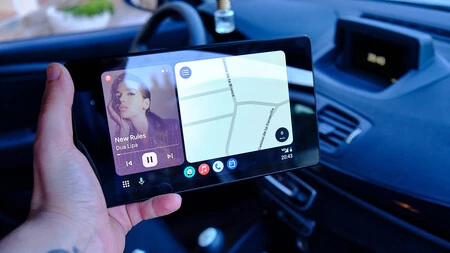I love technology and am passionate about trying new devices. I usually have, due to my work, easy access to the news to always be up to date. At least, that’s what I try. However, something I’ve wanted for a long time, and I don’t think I’ll have it for a long time, is a car with Android Auto.
It is a considerable investment I have a car with a few years behind it, but it’s like new and I don’t use it enough to justify a change at the moment. And that makes me miss something that amazes me like Android Auto. However, recently I’ve gotten bad at work and, as I say in the title, now my stupid car has Android Auto for less than 60 euros. The secret? An old tablet and an app.
The Nexus 7, that big-little Asus/Google tablet
Before I tell you how I turned my Nexus 7 into an Android Auto, let me get a little nostalgic. I’ve been trying to give this tablet a second life for a while, but I’m not able to find a ‘hole’ for it.
A few months ago I saw it in one of my drawers and thought “This was a great pickle in its day, I’m sorry it’s lying there”. The first thing I did was load her and…she loaded her. The battery, surprisingly, still holds up in good condition and, when I started using it while mulling over what use to put it, I fell in love all over again.
It’s the 2013 model.so it’s not the original (that one was immediately outdated) and it still seems like a technological marvel to me. The screen continues to have considerable quality thanks to its very high resolution of 1,900 x 1,200 pixelsThe colors seem good to me, the brightness is true that it falls somewhat short for the use that I am going to give it in the car… and the performance is what I expected.
It has not been short for me to surf the internet and use some basic appsbut there are times when I tap a button twice thinking that the first time I didn’t get the touch and it turns out that it did, so there are times when I accidentally enter some menus.
The speakers are not great, but the microphones still catch me well the voice for Google Assistant and what annoys me the most is the microUSB. I’m not going to blame Asus and Google, it would be missing, but right now it’s the only device I charge with that cable. Well, besides the Sony ZV1 (Sony, that’s enough for you) and the kitchen lighter.

To show that it is a tablet. Luckily, the Nexus 7 fits perfectly into the car’s built-in display gap, and with double-sided tape, it won’t come unstuck on hills or bumpy roads.
It still seems very comfortable in my hands And thanks to its 16:9 aspect ratio, although the screen of almost any current mobile is taller, the width is still the protagonist on the tablet, so there is certain content both vertically and horizontally that is more enjoyable. A web page or a video, for example.
The grip, as I say, is spectacular thanks to its rubbery rear and with a very intelligent curvature and… wow, it seems like a spectacular tablet to me and I don’t want it to be saved for the remains. However, to read it does not compensate me, since I have my I live X80 Pro, and to watch videos… almost neither. The other option was to turn it into an Android Auto.
Turning my old tablet into a fully functional, albeit not perfect, Android Auto

Notifications come out big and you can respond with Google Assistant.
Thanks to the versatility of Androidwe can easily give a second life to old devices. In my case, I have already commented that I would very much like to try a car with Android Auto, but it is not worth buying a new one when mine is luxury just for that feature.
So, taking an example from the article that my colleague Iván Linares wrote some time ago, I decided to install the Headunit Reloaded Emulator for Android Auto application on the Nexus 7. Basically, it is an application that allows you to project the Android Auto from your smartphone as we would do in a compatible car.

The split screen of Android Auto is a joy. I have my favorite apps at the bottom and playback on the left. You can also set it on the right with the browser on the left.
And it is that, in essence, Android Auto is that, a “mirror”: the vehicle has software prepared to communicate with our phone and run a simplified Android interface for driving, Android Auto. It is not that the car has hardware and software focused on running Android Auto, but it is the phone that sends the data to the vehicle.
I have simplified it a lot, I know, but what I want to say is that Android Auto is quite simple and it is replicated with the application that I have discussed. The application is paid and costs almost five euros, but it is worth it.

It has a free version that has some cut features (for example, Apple Music or Telegram don’t work and the resolution is ridiculous), but it allows you to get an idea of what you’re going to find. Oh by the way, the “less than 60 euros” It’s because the price of the second-hand Nexus 7 is around 55 or 55 euros plus the 4.89 euros for the app.
When you enter the page of the app in the Play Store, a tutorial appears. I recommend you to follow it as it helps you in the system setup process. You have to prepare both the app and the mobile itself, and then I will tell you how to do it:
- The first thing you should do is go to the settings section of your phone and search for “Android Auto”. Once this is done, open the settings section (Android Auto stopped being an app a long time ago) and navigate to the version number.
- Press several times to open the developer settings (as if you wanted to activate developer permissions on Android).
- When developer settings are active, tap ⋮ and select ‘Start Head Unit Server’.

It is still a tablet, so at any time my companion can take it to choose the destination or the playlists.
done this, your mobile is already prepared to project Android Auto to the application, but it remains to configure Headunit Reloaded. The application will guide you and the easiest thing to do is to connect the mobile phone and the tablet via USB, but it is really more convenient if the connection is wireless.
Open the Headunit app and follow the process indicated. Create a Wi-Fi hotspot on your mobile, connect the app to said mobile and click on the ‘Wi-Fi’ button on the Headunit. It will tell you to download an app –here you can download it– on your phone. Do it, configure the necessary permissions… and that’s it.
If, for whatever reason, you click on ‘wifi’ again in the Headunit and nothing happens, go to the Wi-Fi launcher and click on ‘Start Wi-Fi service manually’. It should work perfectly there. At that point, Android Auto is launched on the tablet and you can start using it normally.

Big browser and little player.
The truth is the operation of the application is quite agileyou can switch between Waze or Google Maps with no problem and I can use my music service seamlessly so I have both Apple Music as Amazon Music Unlimited.
If they send me a Telegram message, it appears big on the screen and I can reply with the function of transcribing messages from Google Assistant in a simple and, above all, safe way. You can rearrange your app grid, set Android Auto split screen to have the browser and the player and, ultimately, to play with all the options that the system has to offer.

Now, there are three things that you should keep in mind. The first is that you must place the tablet at a point where it does not disturb the vision both because of the possible penalty and because of the distractions it can cause. It is very cool to put it at eye level or on a support under the rear-view mirror, but it is not ideal.
The second thing is that it is possible that there are some failures in the connection and Android Auto does not launch. In this case, check that the tablet is connected to the mobile’s Wi-Fi hotspot. And the third thing is that the tablet consumes a lot of battery in this mode, so If you plug it into the cigarette lighter socket or a USB, better than better.
In Xataka Android | How to watch YouTube on Android Auto
In Xataka Android | Do your Android Auto apps disappear?
In Xataka Android | A car giant turns its back on Android Auto: General Motors will not use it in its electric cars


